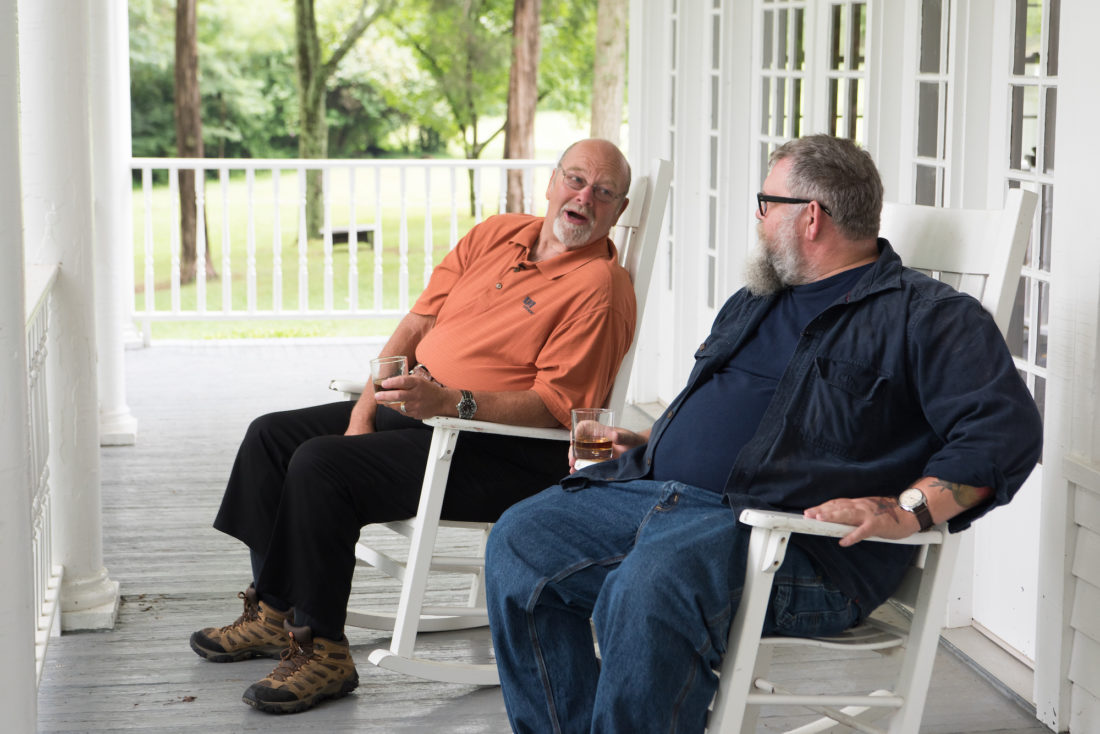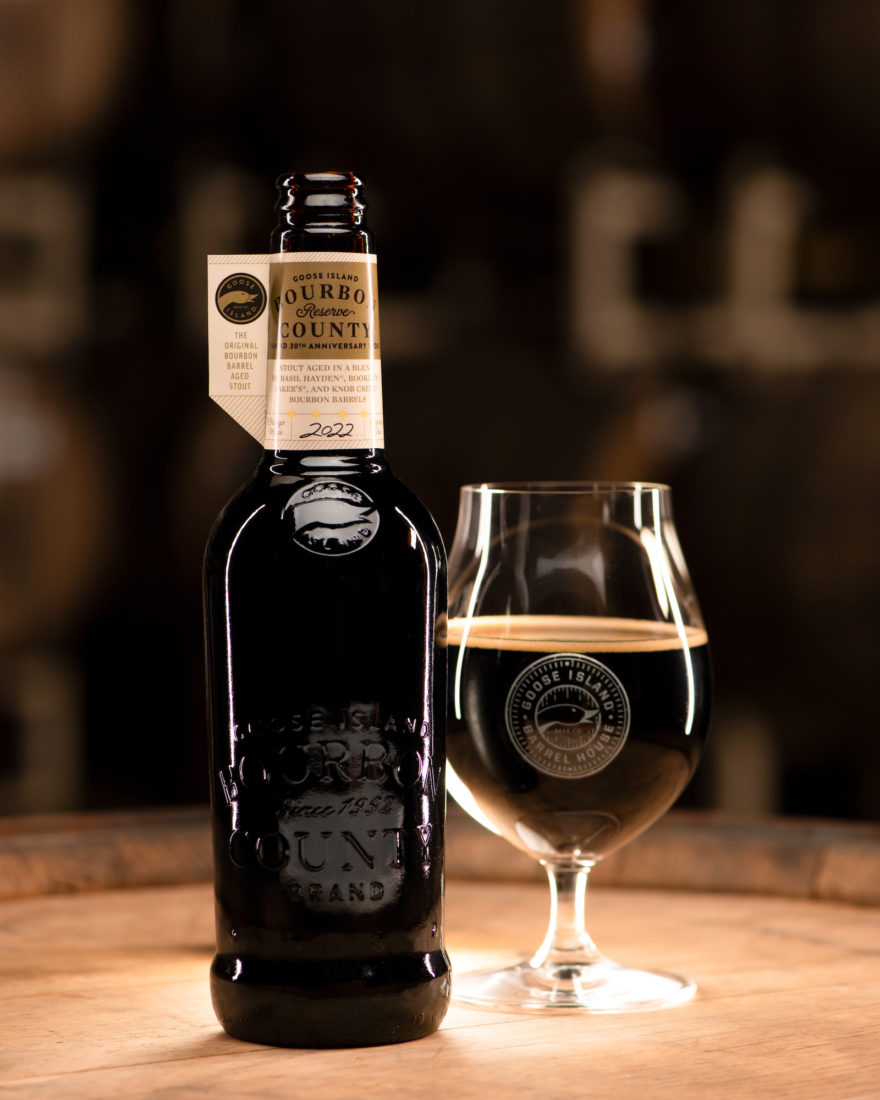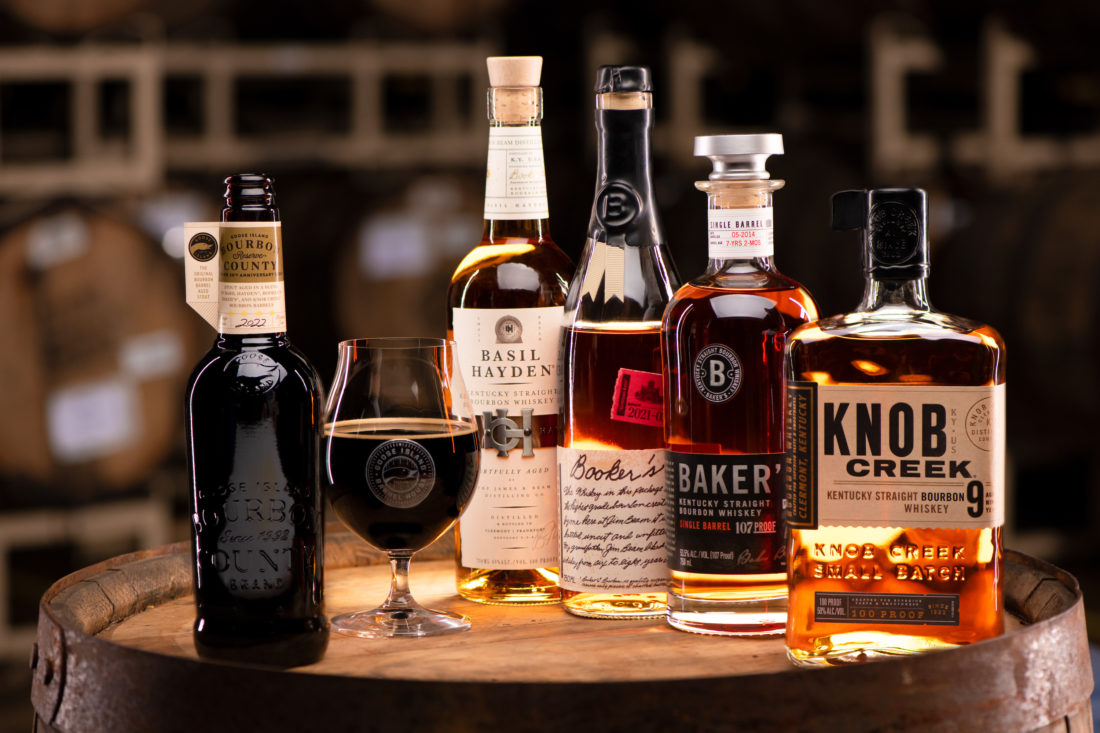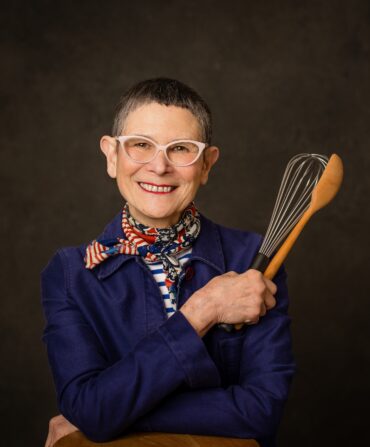Todd Ahsmann slides the six-ounce tasting glass closer to him, gently swirls the dark brown liquid therein, and then lifts the glass to his nose, breathing in deeply.
“I’m getting a bit of chocolate on the nose,” he says.
Then Ahsmann takes a sip, observing the fluid with his tongue, opening his mouth to let fresh oxygen unlock layer upon layer of flavor, even after he has swallowed.
“There’s vanilla, some molasses,” he says. “Some cherry, almond…oak on the back end.”
Ahsmann voice echoes against vaulted ceilings and brick walls lined with charred white-oak barrels, stacked four high, each filled with aging alcohol. But this isn’t a typical Kentucky rickhouse, nor is it some cellar in the heart of Napa wine country. It’s the Goose Island Barrel House, where the Chicago-based craft-beer pioneers age their imperial stout for up to sixteen months in used bourbon barrels.
Tonight, Ahsmann, president of Goose Island, is leading an advance tasting of 2022’s Bourbon County Brand Stout (BCS), released annually nationwide on Black Friday and hunted by beer lovers for weeks thereafter. This year, the brewery is commemorating the thirtieth anniversary of the night Goose Island brewmaster Gregory Hall met Jim Beam master distiller Booker Noe II at a beer, bourbon, and cigar dinner in Indiana, and on a whim, the two came up with the wild idea of aging Hall’s then-unremarkable imperial stout in some of Noe’s freshly emptied Jim Beam barrels. The result has become one of the best-known and highest-rated beers in the world.
It’s also, arguably, one of the most influential. When Goose Island began to develop the Bourbon County Stout in the early 1990s, American beer could be summed up in three words: Miller, Coors, and Anheuser-Busch. For decades, the triumvirate of mega-brewers had flooded the country with slightly different versions of the same yellow lager that was, to put it mildly, easy on the palate. Meanwhile, the coming craft beer revolution was only just starting to bubble over from the basements of hobbyist homebrewers. Even the most novel homespun IPA or porter was still largely looked at—and guzzled—as the same working-class libation European immigrants had brought over three centuries before.

In the ensuing three decades, BCS would change that. Here was a beer that took months rather than weeks to make, and that time spent in cooperage formerly occupied by bourbon added complexity in feel, smell, and flavor—not to mention some extra alcohol, registering at a then-unthinkable 14 percent ABV, nearly three times that of Budweiser, on par with a glass of Bordeaux. Like wine, this beer demanded a drinker’s time to sip and savor. But it and its many imitators have borrowed something from the bourbon barrel beyond tannins and booziness—an American origin story.
Beer in America was then an imported idea. Even what passed for domestic beer was just a mass-produced, watered-down version of a pale lager style brought over by nineteenth-century German immigrants who became U.S. beer barons. But Bourbon County Stout brought something new to beer, and everything that made it unique, from the American white oak staves to remnants of corn mash to the mythology of bourbon-making, came from this country. Particularly, the South.

Today, pretty much any craft brewery you walk into anywhere in the U.S. has at least one barrel-aged offering. And while what may well be America’s biggest brewing innovation might have officially started in Chicago, it would never have happened if not for a key contribution from the unlikeliest part of the country.
* * *
There’s good beer in the South. Some damn good beer. But it’s no secret it’s taken the region a bit longer than other parts of the country to join the craft beer party. “Craft beer had a slower start in the South because the beer industry was slower to start in the South,” says Theresa McCulla, the curator of brewing history at Smithsonian’s National Museum of American History. “For reasons related to climate and urban development and legislation, the conditions for brewing beer in the South were much more difficult.”
Climate is a major factor because it underpins some of the others. Simply put, beer requires colder temperatures to produce, store, and transport—it tends to spoil much easier than wine or distilled spirits. Not only were the Southern colonies too hot for many homebrewers, but the warmer climate also led those economies down a more rural agrarian path. While English and Dutch immigrants brought their beer-making tradition to rapidly growing (and drinking) industrial Northern cities like Philadelphia and New York, there were far fewer large urban centers in the rural South, which meant fewer European immigrants to brew and drink beer and less-extensive transportation networks by which to ship ingredients in and beer out in time to drink it.
That lack of interconnected urban centers came into play, too, in the mid-nineteenth century when Irish and, especially, German immigrants rushed into mid-Atlantic and Midwestern cities. In Cincinnati, St. Louis, and Chicago, the Germans found cooler temps and caves in which to lager (age) and store their native styles of beer for weeks, which provided the foothold for German American beer–synonymous names like Pabst, Busch, Miller, and Schlitz.
Also beginning in the 1800s, the rural conservative South was a hotbed for the burgeoning temperance movement. “Most Southern states became dry before national Prohibition,” McCulla says. “In some cases, a full decade before Prohibition, so those states went a decade or more longer without any breweries in operation.”
Even after Prohibition was repealed in 1933, many Southern states and counties maintained quirky alcohol laws, which remained extraordinarily restrictive into the twenty-first century. For instance, Mississippi and Alabama didn’t legalize homebrewing until 2013, and until recently in Tennessee, any beverage with an ABV of more than 6 percent was taxed as liquor. Needless to say, when craft breweries started sprouting in the 1990s and 2000s in California, Colorado, the Northeast, the Pacific Northwest, and Chicago, brewers in the South had to combat a gauntlet of obstacles in order to join the movement.
Bourbon, on the other hand, was in the region’s blood. But that doesn’t mean it has always been successful. Prohibition nearly wiped out the industry altogether, and later in the 1900s, consumer dalliances with other, lighter spirits, from gin and rum to tequila and vodka, periodically bounced bourbon from the bar. The modern bourbon boom didn’t really start until the 1980s and 1990s, with the advent of small-batch and single-barrel offerings that lifted bourbon back to the top shelf.
All that to say that, by the time Hall and Noe bumped into each other, both parties had something to gain from the marriage of their methods.
* * *
Not that either of them knew exactly what they had when they opened that first barrel of beer.
No one really did. When Hall entered a batch into competition at the 1995 Great American Beer Festival, BCS didn’t fit into any of the established categories at the time and was disqualified (though the judges did think enough of the novel brew to give it an honorable mention).
In fact, BCS wasn’t packaged until 2005. And it wasn’t until 2010, when Goose Island released its Rare Bourbon County Brand Stout, aged for two years in twenty-three-year-old Pappy Van Winkle barrels, that the brewers and their drinkers started to really understand what their mad science had wrought. “That was the first time we really leaned into the provenance of the specific barrel we chose,” Ahsmann says. “That’s when it clicked for us and for beer lovers that you really get this nuanced flavor from the whiskey in the beer. Before that, people thought that sophisticated snifter of beer wasn’t deserving of that kind of ritual.”
That same year, the brewery released other BCS variants like coffee and vanilla. They also began building anticipation with a limited Black Friday release, attracting lines of avid beer connoisseurs eager to get their hands on the latest iterations.
In 2011, Goose Island was bought out by Belgian conglomerate Anheuser-Busch InBev, the largest brewer in the world; and while it was no longer technically craft, the brewery’s barrel-aging program continued to put out top-quality offerings and had already inspired scores of the thousands of breweries popping up across the country.
Today, an annually released barrel-aged beer, usually a stout aged in bourbon barrels, is a rite of passage for any craft brewery. Having the space, budget, and resources to brew an imperial stout, barrel it (used bourbon barrels can run from $50 to $200 apiece for the limited name-brand cooperage), and then sit on it for a year or more signals that a brewery has reached firm financial footing. It’s also a declaration that a brand has built a fanbase willing to pay top dollar for it. Studies indicate that a barrel-aged stout sells for more than $1 per ounce sold, far more than any other style.
“It’s a way to offer something new to consumers who are continually demanding novelty,” McCulla says. “It gives certain beers new character in how and when they’re enjoyed and encourages customers to anticipate certain kinds of beer at a certain moment. It creates a new experience for the customer and new enthusiasm for these richer experiences.”
It also created a mythology around beer that was purely American to be shared at taprooms, brewpubs, and fancy barrel-room tastings. And who knows? Perhaps one day, beer will overtake bourbon as the true national libation. After all, some distilleries are already starting to finish their whiskeys in beer barrels.








